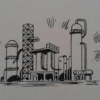Hi,
Im trying to design condenser for vapor compression cycle. My problem is , how to find heat transfer coefficient for superheated vapor. from the resource I read, i need to check either the the wall temperature is below or above the saturation temperature to check will the condensation will directly occur. but no proper guidence is given. whats the best way to check the wall temperature and if the saturation temperature is above saturation temperature, how to determine its coeffcient and find the overall coefficient. The condition of the fluid is below:
Superheated temperature:409K
Saturated temperature: 316K
Available coooling water: 296
Thanks

 FB
FB












